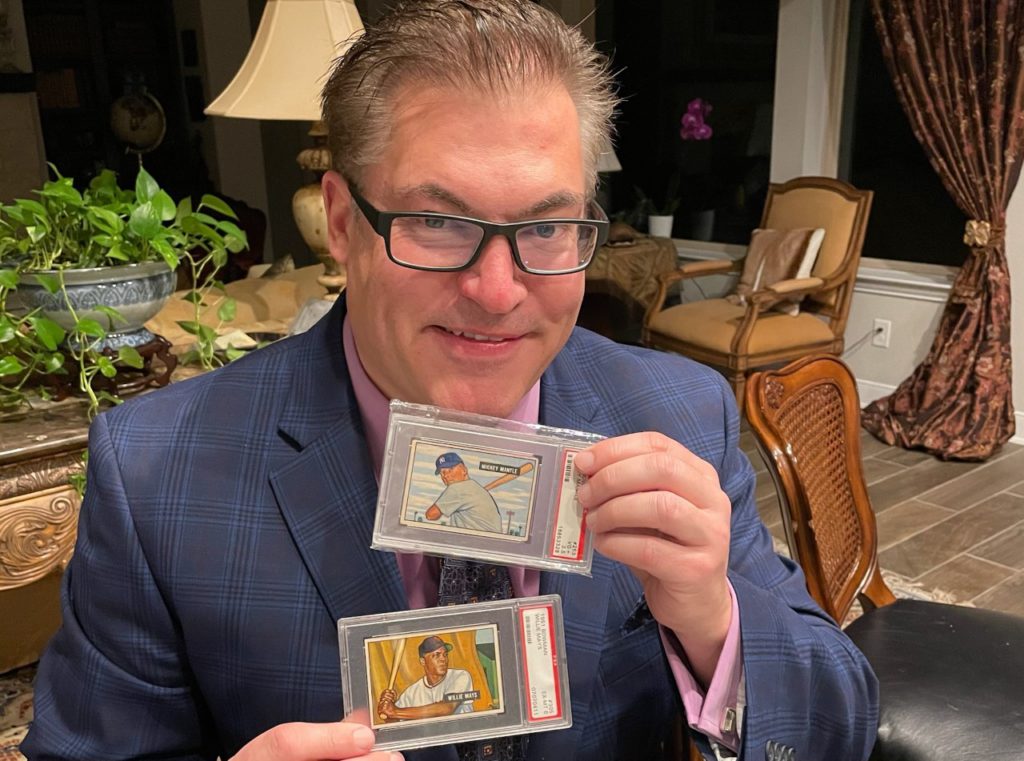The 1950s was a magical time in America. As the pain of World War 2 was fading, the 1950s became the era of “Mom, baseball and apple pie!” The economy was booming and the kids that would make up the Baby Boomer generation were entering school. The 1950s was also a decade where some of baseball’s greatest rookies were coming of age.
Collectors Dashboard evaluates high-end collectibles as an alternative asset class. Some of the top baseball rookie cards from the early 1950s cost enough the greatly exceed a typical stock or bond investment. These are the top 10 baseball rookie cards from 1950 to 1955.
Bowman and Topps were in a fight for the soul’s of boys who wanted to buy baseball cards and bubble gum. The great baseball players of the day were a great way to sell more gum. As Major League Baseball began to integrate in the late 1940s, more talented players were able to come into professional baseball. This also helped to expand the pool of potential baseball card collectors.
Players like Mickey Mantle, Willie Mays, Eddie Matthews, Hank Aaron, Roberto Clemente and many others came into baseball in the first half of the 1950s. They all easily made it into the ranks of Baseball’s Hall of Fame in Cooperstown, New York.
Collectors Dashboard has compiled the top 10 rookie cards of the 1950s, but we have a debate going that has never been resolved. Which cards should and should not be referred to as rookie cards? The Mickey Mantle debate is hard enough, as is the Willie Mays debate, but we have tried to address this.
The super-stars of the early 1950s had baseball cards issued by Topps and Bowman which contained many production errors. There were also printing challenges of the era, and not much consideration about how long these cards might last or the condition at the time of printing. Neither Topps nor Bowman cared if the centering was atrocious. They didn’t mind if the printing ink bled or came with deep lines.
Despite printing issues and centering, both Topps and Bowman did move to much more visually attractive cards to help sell their gum. After all, the unattractive 1940s cards were just not a great enticement to spend money.
We have posted each of the top rookies of 1950 to 1955 in the order they were printed rather than based on values. Otherwise, you would know which one comes first — and you would know it’s not even a true rookie card!
While we have labeled the article a Top 10 list of the 1950 to 1955 period, it is actually a Top 12 because of the repeat cards for Mickey Mantle and Willie Mays. Please note that population reports were compiled in late August of 2021 and are being refreshed as PSA, SGC and other grading outfits get their population reports updated based on the flood of cards that were submitted in 2020 and in early 2021.
1) Whitey Ford – 1951 Bowman #1 (Image – Heritage Auctions)
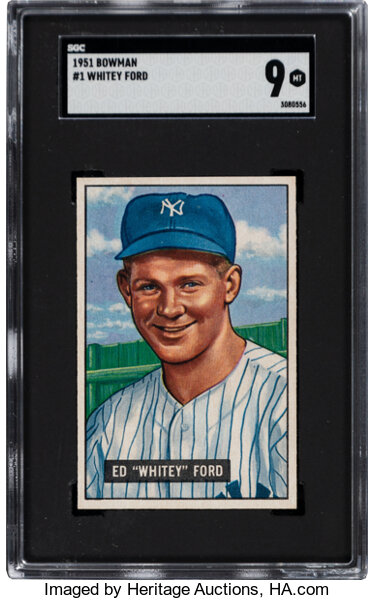
Whitey Ford was one of the three top rookies of the 1951 Bowman set, and it was more than unusual for the #1 card in any baseball card set to be a rookie player. While coming in the second half of the 1950 season, his rookie enshrinement was winning 9 games and losing only 1 game with a 2.81 ERA. Ford was also out of the 1951 season to serve in the Army, with no major Topps nor Bowman cards issued in 1952. Ford played his whole career pitching for the Yankees and ended with 236 wins and 106 losses, with a career 2.75 ERA and 1,956 strike outs. Whitey Ford was among the oldest living players until dying at almost 92 years old in 2020.
Most of his 1951 Bowman cards are graded in a PSA range of 2, 3 and 4 and PSA also counted just 1,625 graded examples. SGC’s population report had just 428 graded examples with the dominant grades coming in the 3, 4 and 5 grades.
The 1951 Bowman Whitey Ford rookie is still quite affordable in less than mint condition. A PSA 5 example sold for barely $1,000 in a PWCC/eBay auction in May of 2021, but in June 2020 a PSA 8 example sold for $30,463.20 in Memory Lane’s Newman Auction that garnered so much attention along with the Babe Ruth cards. The PSA category had seen prices in the $10,000 to $11,000 range is 2020 and had only generally appreciated about 20% since other sales in 2012-2015 when prices were choppy.
2) Mickey Mantle – 1951 Bowman #253 (Image – Jon Ogg)

This Mickey Mantle rookie card is the best of the true rookie cards of the 1950s, but it always takes the backseat compared to the 1952 Topps Mantle both in price and in demand. Mantle was the Yankees’ team leader in the 1950s and 1960s. He ended his career with 536 home runs, a .298 batting average and 2,415 hits. Mantle was known for playing hard on and off the field. He suffered injuries which may have kept his stats considerably lower than had he been health his entire career. From 1952 to 1964, Mantle was on every All-Star team and only batted under .300 in three seasons in that same time.
Along with poor centering being more common than not in this high-numbered card issued late in the season, the 1951 Bowman Mantle card often suffers from printing lines and wax lines. PSA counts 2,370 graded examples of this card, and SGC’s count of another 700 graded examples are typically seen in grades of 3, 4 and 5.
Mantle’s Bowman rookie comes for sale routinely, but PSA 8 examples commanded $480,000 from Heritage Auctions in July 2021 and a PSA also commanded $498,000 in the well known Memory Lane Newman Auction from June 2021. Despite the heritage of this card, it still routinely sells for less than half of Mantle’s 1952 Topps card.
3) Willie Mays – 1951 Bowman #305 (Image by Jon Ogg)
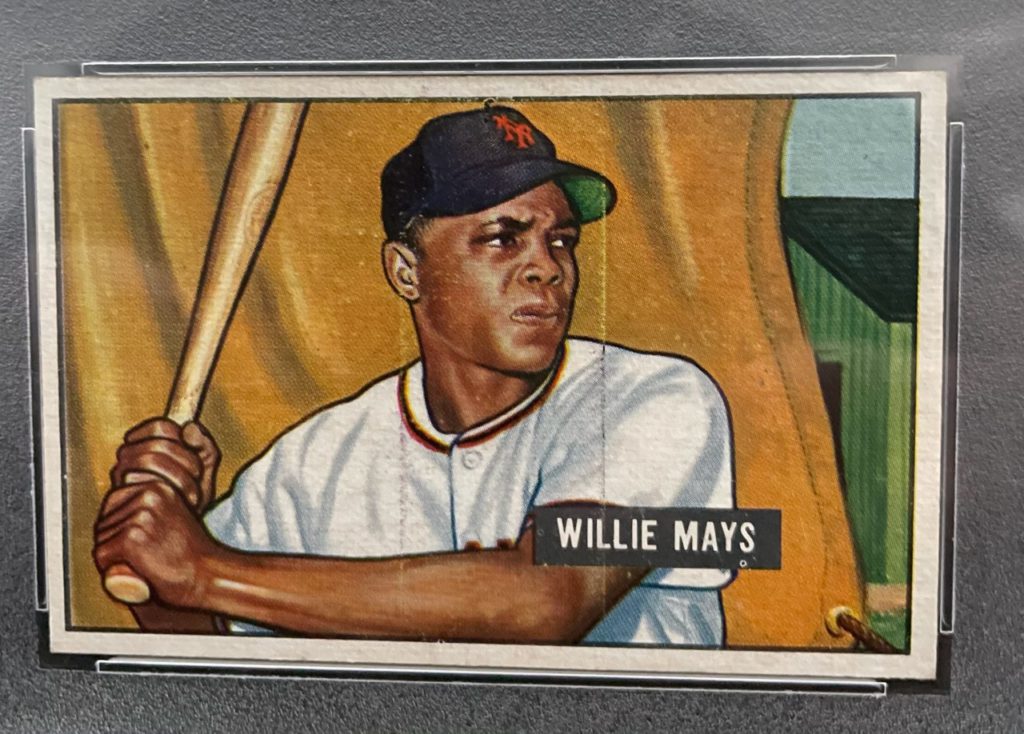
Despite some collectors also considering the 1952 Topps Willie Mays a rookie card, collectors all give way that the 1951 Bowman is his real rookie card. It is also generally the case that the 1951 Bowman Mays will be at a higher price than the 1952 Topps Mays card.
Mays ended his career with a .301 batting average, but like many aging stars that average was pulled down in his late years. He did not hit over .300 after 1965, which lowered his career average up to retirement in 1973. The “Say Hey Kid” was known for “The Catch” and being the highest paid (salary) MLB player of the entire 1960s. Where Mays stands out is his whopping 660 home runs and he also had 3,293 all-time hits.
PSA has a total population of 1,990 graded cards, with the straight PSA grades coming in 3 to 6. SGC’s 554 graded examples of this card are most frequently seen in graded of 3 and 4. The 1951 Mays cards are still often readily under the $10,000 mark for grades of PSA 4 and under, but the prices rise handily from there. A PSA 7 sold for $51,660 from Goldin Auctions in August 2021 and a PSA 8 sold in May 2021 for $234,000 by Heritage Auctions.
4) 1952 Topps Willie Mays #261 (Image – Heritage Auctions)

This is yet another instance where collectors frequently refer to a rookie wrongly, and the 1952 Topps Mays usually sells at a discount versus the 1951 Bowman ‘true rookie’ Willie Mays card. The card is also not as rare as some of the 1952 cards. PSA counts more than 2,500 total graded examples and SGC counts 641 graded examples in its population. As Mays’s career has been covered already, that is the end of his notes.
Willie Mays’ career was already highlighted, but his 1952 Topps card can fetch significant prices at auction for the higher grades. The population of base grades without qualifiers is now 2,010 cards and another 321 cards have the .5″ designation. The largest grouping is is 413 at the PSA 4 category with 413 examples, and another 60 cards at the 4.5 grade.
5) Mickey Mantle – 1952 Topps #311 (Image – Jon Ogg)
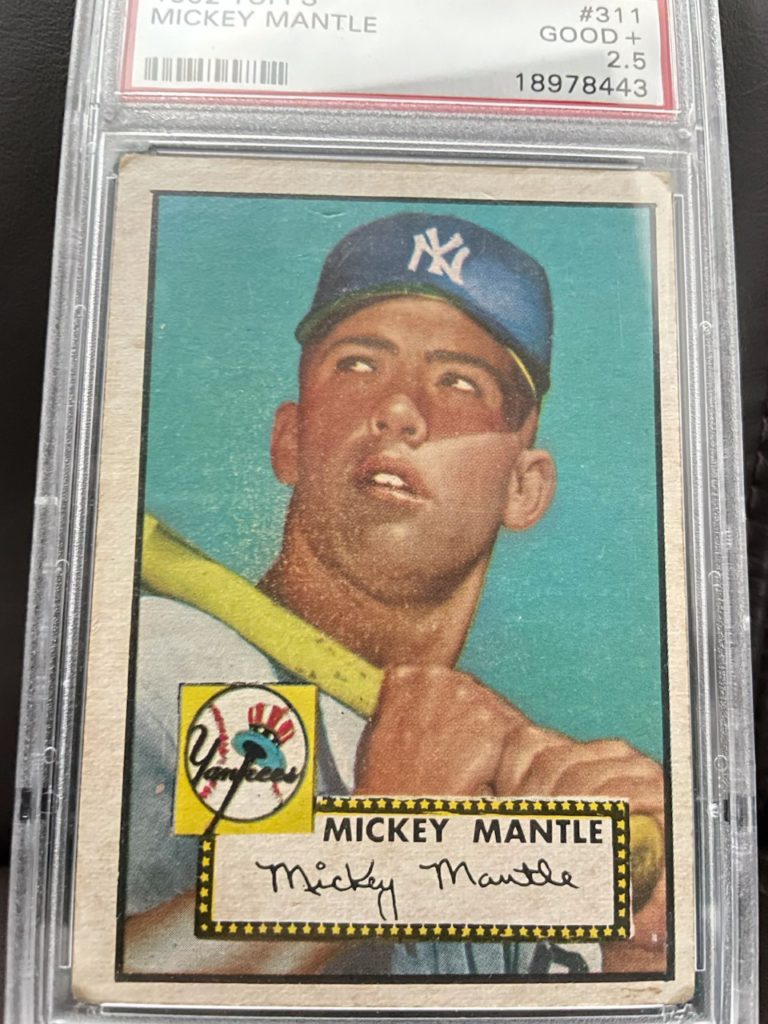
The 1952 Topps Mickey Mantle card is undeniably not his rookie card. Many collectors still refer to this card as the “Topps Mantle rookie.” One additional reason for its inclusion here is that the 1952 Topps Mantle is perhaps the number-1 face card for sports card collecting. Examples of this rookie come up for auction routinely despite such a high card price.
This Mantle card has been reported to be worth more than the T206 Honus Wagner in the PSA 9 and PSA 10 categories. The reason is not the scarcity but the late-year run for the high-numbers and its printing so frequently being off-center as it was the top corner card on the uncut sheets from Topps that year. This is also from the set that made Topps what it is, ultimately allowing it to overpass and acquire Bowman.
A Mister Mint find is credited for most of the top condition examples remaining. PSA counts 1,787 graded cards in the population report, with the highest concentration (300) at the PSA 1 level. There are then 199 base grades at PSA 2, followed by 189 at PSA 3 and 196 at PSA 4.
6) Eddie Mathews – 1952 Topps #407 (Image – Heritage Auctions)

The 1952 Topps set was a larger format than the Bowman cards had been in prior years. Kids who weren’t ruining their cards in bicycle spoke and flipping games loved to use rubber bands to hold their cards together in bricks. Being the last card in the series means that the Mathews card is subject to having deep rubber band indention and other notches or damage from excessive handling or bad storage practices.
Eddie Mathews went on to hit 512 home runs in his MLB career, and his career .271 batting average is overshadowed by a .509 career slugging percentage. Along with being the last card in the set, the high-number release meant that the card just isn’t that common. The centering on this card is also off-center more often not.
PSA has a total population of just 839 examples, with PSA 3 and 4 being the highest concentration of grades. SGC’s total population is just 192 graded examples with the highest samplings in SGC 3 and SGC 4 grades. Of the top 1950s rookie cards listed here, the 1952 Topps Eddie Mathews card has the lowest graded population by far.
This makes the Eddie Mathews rookie the most rare by number of graded examples of these 10 cards. It is not the most valuable, but it gets pricey the higher up the grades go.
7) Ernie Banks – 1954 Topps #94 (Image – Heritage Auctions)
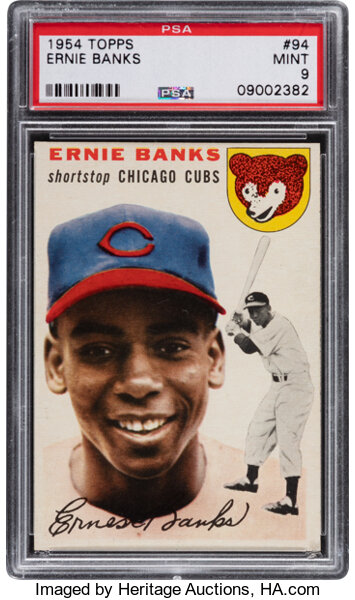
Whether Ernie Banks should be known as “Mr. Cub” or “Mr. Sunshine,” his 1954 Topps rookie looks as if a teenager showed up for Topps’ photo day. This is the best Ernie Banks card out there, and the cards from his years thereafter are quite affordable considering how popular he was in Chicago and off the field. He was a player-coach from 1967 to 1971 and was at one point considered the greatest Cubs player ever.
Ernie Banks ended his career with a .274 batting average, quite low for his fame, but his career 2,583 hits was overshadowed by hitting 512 homers. Banks also routinely had a slugging percentage above .500 in the first 10 years of his 19-year career.
One issue which makes the 1954 Topps card stand out so much is that the whiteness throughout the banks card usually was bright colors for other players. That makes it easy to overlook any chipping and it can deceive the off-centering found on many of the rookie Banks cards. The total population is quite high for the first half of the 1950s with about 4,700 graded examples at PSA. The highest concentration examples are in PSA 4 (683) and PSA 5 (626). SGC’s total population is 1,139 cards and the bulk of them are graded SGC 4 and 5.
While PSA 4 and PSA 5 equivalent cards can be purchased for under $2,000 generally, higher graded become much more expensive. Two examples of a PSA 7 sold in July, one for $10,054 and one for $7,511. All PSA 8 grades sold above $20,000 in 2021 for cards without qualifiers, handily higher than the $9,000 or so (with some higher) in 2019.
8) Hank Aaron – 1954 Topps #128 (Image by Jon Ogg at #NSCC21)
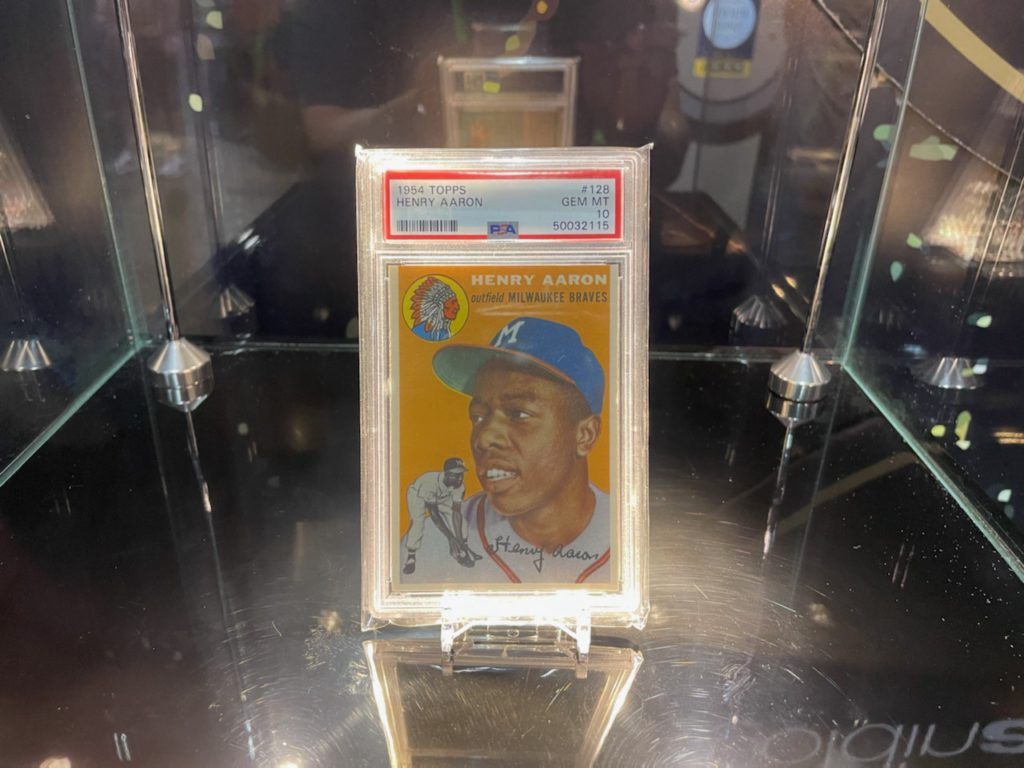
The orange presentation of the 1954 Topps Hank Aaron is visually appealing to many collectors. It may be ironic that he is fielding instead of batting, but Topps had no clue Hank would challenge (let alone break) Babe Ruth’s home run record. One issue which can be a challenge for the 1954 Topps card is centering, and its edges are usually shown to have a rough cut. While PSA and other graders do not penalize the card for the edge cuts, it makes the pristine examples shine over those with rougher edges.
While the Hank Aaron rookie is highly sought after, the population is actually quite high. PSA counted 4,680 base grades, another 825 examples with “+” grades and another 357 with qualifiers. SGC counts another 1,433 graded examples, with the largest number at 3 (208 count). This high population keeps Hank Aaron’s rookie card more affordable in grades up to the PSA 6 or PSA 7 levels, a blessing for collectors and perhaps value-limiting for collectible investors. As the rookie Aaron cards reach PSA 8, the grades get tougher and the prices can easily climb above $50,000 as of mid-2021. The bulk of the Aaron base PSA grades are in the “4” and “5” level, at more than 900 each.
Hank Aaron was the home run king long before there were steroids being used like candy. His 755 career dingers came from a steady and consistent flow of smashes rather than from overwhelming numbers in any single season. The quality of his homers did not measure up to Babe Ruth’s quality based on total at-bat stats. Aaron never hit 50 homers in a single season. He still ended with a massive 3,771 total hits and .305 career batting average, as well as a very impressive .555 slugging percentage.
9) Al Kaline – 1954 Topps #201 (Image – Heritage Auctions)
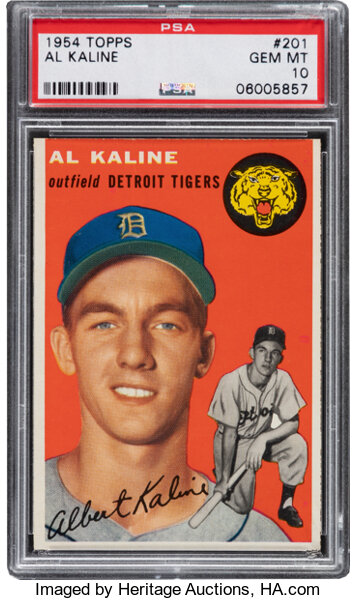
Al Kaline spent his entire career with the Detroit Tigers. Had he worn a different uniform he may have been more revered by fans around the country. This red front presentation is rather attractive for the 1954 Topps set, and the card shines in its pristine grades. Centering can be an issue here.
In his 22 years as a player, Kaline finished his career with 399 home runs. While that may be just under the 400-club, Kaline did manage to get 3,007 career hits and managed 1,582 RBIs. He also ended with a .297 batting average and a .480 slugging percentage.
Al Kaline’s rookie card is represented by PSA having 3,649 total graded examples. The highest concentration is in PSA 4 with 625 with 106 at half grade and 23 qualifiers . SGC has 811 total graded examples. The highest SGC concentration is grade 5 with 152 examples. Grade 4 has 121 examples and grade 3 has 119.
10) Sandy Koufax – 1955 Topps #123 (Image – Heritage Auctions)
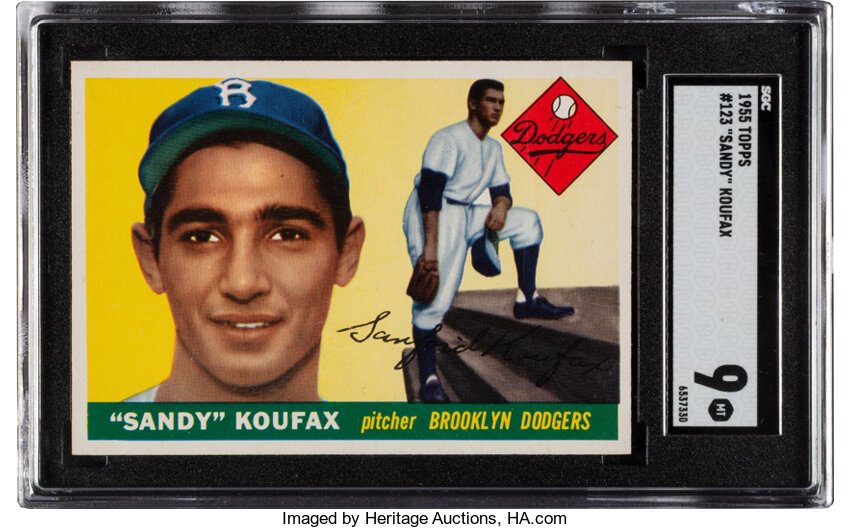
Sandy Koufax would be the best known vintage Dodger player of all-time had it not been for teammate Jackie Robinson. Koufax was up and coming in the league right before “Dem Bums” snuck out of Brooklyn in their move to Los Angeles. His light yellow background makes for a visually appealing card when it is a clean print. Some of the printings were just cleaner than some of his others, and that can make printing defects stand out. This card is more easily obtained than some rookies due to a high population.
Koufax was a hard thrower who could have likely pitched more seasons had he lightened up or had a modern relief pitching lineup — or had the Tommy John surgery been known. His last season (1966) was his best with 27 wins and a career low 1.73 earnings run average, which would explain his persistent elbow pain. Koufax struck out 2,396 batters over his career, averaging 1 strikeout per inning, and ended with an earned run average of 2.76.
PSA has 8,975 graded examples with the highest concentration at grade 5 with 1,543 with 180 at half grade and 42 qualifiers. The 1955 Topps #123 has 1,915 total graded examples at SGC, with the highest concentration at 285 in grade 5, as well as 266 in grade 3 and 263 in grade 4. This card is still affordable in the lower grades but the prices can rise rapidly in the less populated highest grades.
Sandy Koufax is actually the card with the highest graded population of the top rookies noted in this piece.
11) Roberto Clemente – 1955 Topps #164 (Image – Jon Ogg)

If one baseball player from Pittsburgh is more popular or more well-known than Honus Wagner, it’s Roberto Clemente. This card is from the beautiful 1955 painted set where the facial poses were generally used for the 1956 Topps card portraits. It was also the last year that Topps had to compete against Bowman and its television set design of that same year (which was missing key rookies). The green background was very appealing to the eye, but Clemente’s rookie is rarely seen with the best centering. Many cards were printed almost entirely off-center and many examples have bad print lines on the card.
Clemente’s accidental death in a plane crash while still an active player made him an instant Hall of Famer, but he was destined for Cooperstown already. He is the only player to end his career with an exact 3,000 hits. And after 1960, Clemente only had one season batting under .300 (.291 in 1968). His home run count was only 240, but he ended with 1,305 RBI and a .475 slugging percentage.
PSA has 5,944 graded examples. PSA’s highest concentration grade 4 has 1,010 examples with 135 at half grade and 126 qualifiers. His SGC population is 1,507 and the highest concentrations are 252 in grade 3 and 216 in grade 4 with 191 in grade 5. While many graders are a bit forgiving on centering, the card’s persistent off-center issue makes the higher graded examples stand out handily.
12) Harmon Killebrew – 1955 Topps #124 (Image – Heritage)

Killebrew’s 1955 Topps comes with a bright yellow background. If he looks like a kid in the image, it’s because he was a teenager. The card bragged about a big signing bonus after having been found playing sandlot ball in Idaho. It is by far the most valuable Killebrew card of them all and it is stunning when you see it in the equivalent of a PSA 8 or higher.
Harmon Killebrew’s 1955 Topps rookie is almost a rookie for 4 years because he did not get to play a full season until 1959. That makes his 22-year career come with even more emphasis on hitting 573 home runs out of his 2,086 career hits. That power hitting came with a lower .256 lifetime batting average, but Killebrew ended with a .509 slugging percentage. He also led the American League in homers in 6 different years between 1959 and 1970.
PSA has 5,604 graded examples with the highest concentration at grade 5 with 1,116 with 89 half grades and 39 qualifiers. 1955 Topps #124 has 1185 total graded examples at SGC. The highest concentration is 222 example in grade 5 followed by 161 in grade 3 and 146 in grade 4.
